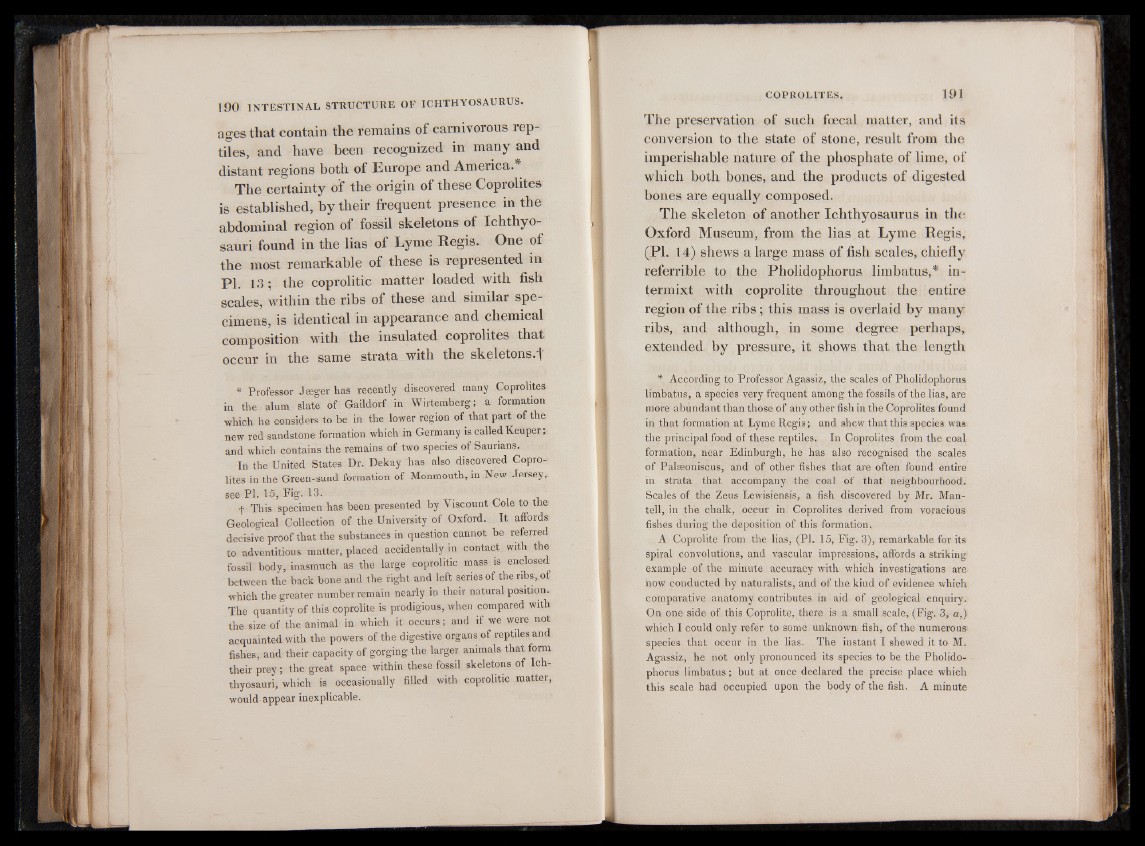
ages that contain the remains of carnivorous reptiles,
and have been recognized in many and
distant regions both of Europe and America.
The certainty of the origin of these Coprolites
is established, by their frequent presence in the
abdominal region of fossil skeletons of Ichthyosauri
found in the lias of Lyme Regis. One of
the most remarkable of these is represented in
PI. 13; the coprolitic matter loaded with fish
scales, within the ribs of these and similar specimens,
is identical in appearance and chemical
composition with the insulated coprolites that
occur in the same strata with the skeletons.'1'
* Professor Jeeger has recently discovered many Coprolites
in the alum slate of Gaildorf in Wirtemberg; a formation
which he considers to be in the lower region of that part of the
new red sandstone formation which in Germany is called Keuper;
and which contains the remains of two species of Saurians.
In the United States Dr. Dekay has also discovered Coprolites
in the Green-sand formation of Monmouth, in New Jersey,
see PI. 15, Fig. 13.
f This specimen has been presented by Viscount Cole to the
Geological Collection of the University of Oxford. It affords
decisive proof that the substances in question cannot be referred
to adventitious matter, placed accidentally in contact with the
fossil body, inasmuch as the large coprolitic mass is enclosed
between the back bone and the right and left series of the ribs, of
which the greater number remain nearly in their natural position.
The quantity of this coprolite is prodigious, when compared with
the size of the animal in which it occurs; and if we were not
acquainted with the powers of the digestive organs of reptiles and
fishes, and their capacity of gorging the larger animals that form
their prey; the great space within these fossil skeletons of Ichthyosauri,
which is occasionally filled with coprolitic matter,
would appear inexplicable.
The preservation of such foecal matter, and its
conversion to the state of stone, result from the
imperishable nature of the phosphate of lime, of
which both bones, and the products of digested
hones are equally composed.
The skeleton of another Ichthyosaurus in the
Oxford Museum, from the lias at Lyme Regis,
(PI. 14) shews a large mass of fish scales, chiefly
referrible to the Pholidophorus limbatus,* in-
termixt with coprolite throughout the entire
region of the ribs; this mass is overlaid by many
ribs, and although, in some degree perhaps,
extended by pressure, it shows that the length
* According to Professor Agassiz, the scales of Pholidophorus
limbatus, a species very frequent among the fossils of the lias, are
more abundant than those of any other fish in the Coprolites found
in that formation at Lyme Regis; and shew that this species was
the principal food of these reptiles. In Coprolites from the coal
formation, near Edinburgh, he has also recognised the scales
of Palseoniscus, and of other fishes that are often found entire
in strata that accompany the coal of that neighbourhood.
Scales of the Zeus Lewisiensis, a fish discovered by Mr. Man-
tell, in the chalk, occur in Coprolites derived from voracious
fishes during the deposition of this formation.
A Coprolite from the lias, (PI. 15, Fig. 3), remarkable for its
spiral convolutions, and vascular impressions, affords a striking
example of the minute accuracy with which investigations are
now conducted by naturalists, and of the kind of evidence which
comparative anatomy contributes in aid of geological enquiry.
On one side of this Coprolite, there is a small scale, (Fig. 3, a,)
which I could only refer to some unknown fish, of the numerous
species that occur in the lias. The instant I shewed it to M.
Agassiz, he not only pronounced its species to be the Pholidophorus
limbatus; but at once declared the precise place which
this scale had occupied upon the body of the fish. A minute